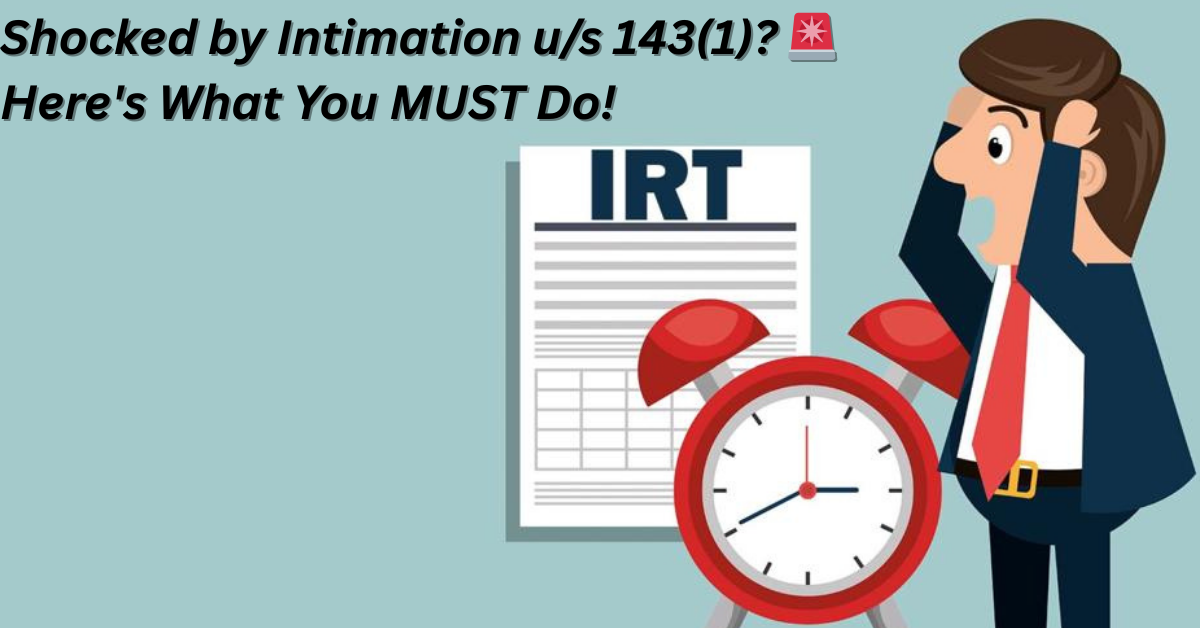How Do You Respond to Intimation us 143 ?
Income tax return processing involves several steps, from filing the return to receiving the refund or paying additional tax. Once the ITR is filed and verified by taxpayer, the processing of ITR starts. The Income Tax Department processes the return, which involves checking for errors, discrepancies, and completeness.
The Income Tax Department sends an intimation under Section 143(1) after processing the return. The timeline for income tax return processing varies depending on the complexity of the return and the workload of the department.
Section 143 of the Income Tax Act, 1961, deals with the assessment of income tax returns. An intimation under Section 143 is a communication from the Income Tax Department to the taxpayer regarding the processing of their income tax return.
What is Intimation u/s 143(1)?
An intimation under Section 143 is a notice sent to the taxpayer after processing their income tax return. The intimation may:
- Accept the return as filed by the taxpayer.
- Make adjustments to the return, such as disallowing certain deductions or adding income.
- Raise demands for additional tax, interest, or penalty.
Types of Intimations under Section 143
There are two types of intimations under Section 143:
Intimation under Section 143(1):
This intimation is sent after processing the return, and it may accept the return, make adjustments, or raise demands.
Intimation under Section 143(1)(a):
This intimation is sent when the return is processed and there are no discrepancies or adjustments.
Here’s the key difference between 143(1) and 143(1)(a)

Note :143(1) is a general intimation, while 143(1)(a) requires a response if you disagree with the adjustment.
Intimation under Section 143: Good or Bad?
Receiving an intimation under Section 143 from the Income Tax Department can be either good or bad, depending on the content of the intimation.
Good Scenarios:
- The intimation may state that the return has been processed without any discrepancies or adjustments.
- The intimation may inform you that you are eligible for a refund, which is a positive outcome.
- The intimation may confirm that no additional tax, interest, or penalty is due.
Bad Scenarios:
- The intimation may highlight discrepancies or adjustments made to your return, which could result in additional tax, interest, or penalty.
- The intimation may raise a demand for additional tax, interest, or penalty, which you’ll need to pay.
- The intimation may require you to provide additional documentation or clarification, which can be time-consuming.
How to Respond to Intimation Under Section 143(1) of the Income Tax Act?
If the taxpayer receives an intimation under Section 143, they should:
- Verify the details mentioned in the intimation.
- Respond to any discrepancies or adjustments made by the department.
- Pay any additional tax, interest, or penalty demanded by the department.
Consequences of Not Responding to Intimation Under Section 143(1)
If the taxpayer fails to respond to the intimation under Section 143, the department may:
- Treat the return as invalid.
- Raise additional demands for tax, interest, or penalty.
- Initiate penalty proceedings against the taxpayer.
FAQs on Intimation Under Section 143(1)
You can download the intimation from the Income Tax e-Filing portal:
1. How to Download Intimation us 143 ?
Intimation u/s 143(1) download process:
- Visit Income Tax Portal and log in.
- Go to ‘e-File’ > ‘Income Tax Returns’ > ‘View Filed Returns’.
- Find the relevant Assessment Year (AY) and click on ‘Download Intimation Order’.
2. Is Intimation us 143 (1) password protected document ? What is the Password to Open Intimation u/s 143(1)?
The password to open the intimation PDF is:
PAN (in lowercase) + Date of Birth (DDMMYYYY format)
Example: If your PAN is ABCDE1234F and your DOB is 15th Aug 1990, then the password is abcde1234f15081990.
3. Why is Intimation us 143 (1) Issued?
It is issued after the Income Tax Department processes your ITR. The intimation informs you about:
No demand, no refund – If your return is accepted as filed.
Refund payable – If excess tax has been paid.
Tax demand – If there are discrepancies, miscalculations, or unpaid tax.
4. What is the Time Limit for Responding to Intimation us 143 (1)?
If no tax demand is raised, no response is required.
If there is a demand for additional tax, you must respond within 30 days of receiving the intimation.
Conclusion
It’s essential to keep track of the status of your income tax return processing to ensure timely response to any intimation or demand. It’s essential to respond to the intimation under Section 143 within the specified time limit to avoid any consequences.
Remember, receiving an intimation under Section 143 is a normal part of the income tax return processing. Stay calm, verify the details, and respond promptly to ensure a smooth resolution. If you’re unsure about how to respond, consult a tax professional or chartered accountant.
✅ Received Intimation u/s 143(1)? Need Help? 💡
Drop a comment below.

